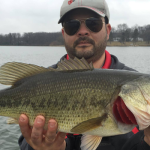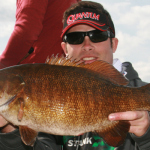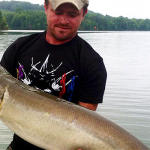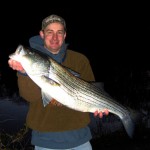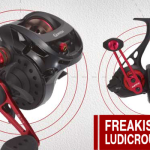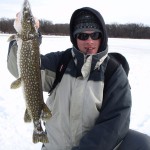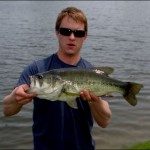By: Roy Vivian – Date Posted: March 22, 2011
The short and cold days of winter are giving way to the warmer and longer days of spring. That can mean only one thing, it is sauger time! From a recreational and tournament angling standpoint there is no better place to catch sauger in March and April than the Illinois River. The largest population of sauger on the Illinois River is in the Starved Rock pool. The key to success in this section, and any other sections of the river, is understanding and adapting to the ever changing river water levels.

Each day before fishing, I check the water levels at the National Weather Service Forecast website for Central Illinois. Here I can find out whether or not the river is going up or down in addition to predicted future levels. High water is not bad to deal with. However, high water that is dirty with ‘chocolate milk’ clarity is not so good.
In addition to water levels, I check the weather to see if rain is on the way. Measurable rain in the LaSalle/Peru area isn’t necessarily a bad thing. However, measurable rain in Chicago usually is a bad thing as the runoff will eventually flow downstream from the Des Plaines and Kankakee River watersheds into the Illinois River system. As a result, water clarity will be muddy. The good news is if the rain is isolated only in the Chicago area it usually takes a few days to make it down the river.
Finally, the last thing I will do is call a local bait shop such our friends at Time on the Water Outdoors, to find out the visibility of the river.
With all of these steps finally taken cared of, you can finally get on the water and start adapting to the river conditions.

If the river is muddy, regardless of river levels, the first thing I look for is the cleanest water in the system. An improvement as slight as an inch of visibility can make a huge difference in the productivity of fishing.
Locating cleaner water can be impossible but there are some things to look for. The first places I check are feeder streams and creeks. Sometimes it is the feeder stream that is pumping in muddy water like the Vermillion or Little Vermillion River. Other times it is the opposite; those rivers are pumping in clean, emerald color, water. If the water is high and muddy, but dropping, the cleanest water will usually be closest to the Starved Rock dam. Other places to look are at the mouth of the backwater lakes and outlets from dams holding back water.

In 2007, the day before the MWC tournament, the river was muddy and rising, well on it’s way to record flood levels. The visibility in areas where I was catching fish had diminished to near zero and I could not get a bite. I finally found a creek that was pumping in clean water. I slid in there with my trolling motor, dropped my jig and plastic down, jigged it once and caught a 2.5 lb. sauger. Shortly after, my partner caught another one that was 3 pounds. We then concluded, thinking that we had found the secret spot. By the time we reached the same location t the next day, there were 30 boats in this small area and the clean water was all gone as the dirty river water backed up the creek.
Of 200 boats participating in the tournament, there were only 4 fish caught and none of them were anywhere near the mouth of that creek!
If water levels are high I will search for current breaks closer to shore in the 12 to 14 foot range. Don’t be afraid to fish shallower though as I have often found big sauger in the 6 to 10 foot, range and in some cases in as little as 2 feet.
Higher water will usually concentrate fish on those current seams. Therefore if you catch one, make sure you cover that area thoroughly. If water level is stable, or dropping, sauger will often spread themselves out into the main channel and can be caught in the 16 to 20 foot range.
My favorite way to catch Illinois River sauger is to slip the river with a jig and plastic combination. Some of my favorites are Hutch’s Ringworms, Paddle Tails, and Berkley GULP!
I was once told that plastics don’t work on the Illinois River. I can assure you that is far beyond from being the truth. Sometimes the fish may prefer a live minnow in opposition of a plastic. When this holds true, I usually have my partner use a live bait jig with a minnow to see which one the fish prefer most.
I like to use the heaviest jig I can get away with, which is usually a 1/2 oz. Hutch River Jig. Meanwhile if I am using minnows, I use a 1/2 oz. Do-It live bait jig that I make myself.
In regard to jigs, it is important to note that the heavier jig reaches the river bottom faster. With heavier jigs, it is easier to keep your presentation vertical and allows you to jig more aggressively. Most importantly, a 1/2 oz. jig allows you to “pound” the bottom.
Usually the best spots to catch sauger in the spring are in areas where there is a hard bottom. Sauger are curious fish and I think this continuous “pounding” draws them in. Sauger are also very aggressive and have no problem sucking into their mouths a 1/2 oz. jig. The best places to jig are on a current seam and sharp breaks that follow the shoreline’s contour. Many times the fish will be holding tight to these areas, making a vertical jigging presentation very effective.
If I am preparing for a tournament, which I will be on the last week of March, I will jig and also try other tactics.

A great place to catch sauger during spring are on the flats, which are areas with little change in depth. Flats are usually located on long, straight stretches of the river. The river bottom of the best areas usually possess hard bottom composition and are often featureless with the exception of humps that are caused by passing barges. The fish are usually spread out making jigging a little more difficult. For these fish the most productive way to catch them is to hand line, pole line, troll lead core or use heavy weights on a three way swivel presentation. You can also use a 3 way swivel with the dropper line being a 1-2 oz. jig tipped with a plastic and a hook or a Phelps floater on the other line. I prefer to use the latter method on current seams, distinct breaks and spots rather than on the flats because I can’t cover as much water.
The key advantage of these tactics is you can cover more water by trolling upstream in an S pattern in comparison to a straight line that is needed to vertical jig. The S pattern also helps trigger fish as the bait speeds up or slows down and pauses. An experienced boat operator can also increase the odds by “sliding” across the current which keeps the stick baits in front of the fish longer giving them a greater opportunity to eat the bait. In areas where barges have created humps the heavier weights used in these presentations keep the baits in the strike zone longer than with jigging.
Many trollers use smaller, Rapala style stick baits that are number 5’s or 7’s. I prefer to use number 9’s and sometimes 11’s. If you think a number 9 or 11 is too big your concern will go away when you catch a sauger that is smaller than your bait!
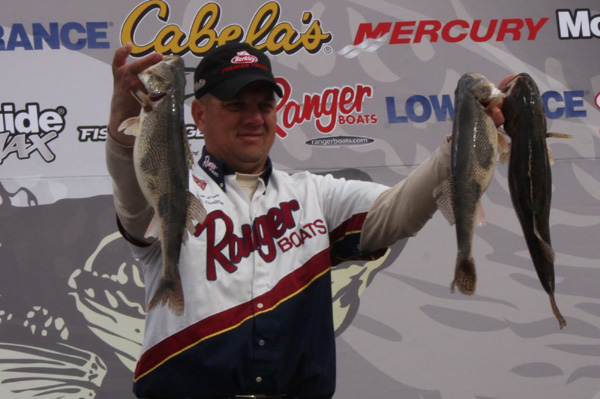
The Illinois River isn’t a glamorous river. In fact, the locals call it a ditch, probably because it is dredged out to allow for barge traffic among other things. However, it is a resilient river full of history. You can catch fish right next to a barge loading coal or next to a beautiful, historical landmark like Starved Rock.
Either way the Illinois River is full of sauger. If you keep an eye on river levels and adapt accordingly, then you are sure to catch your share of sauger! If you happen to encounter a Lund 1975 Pro V with a 225 Verado sometime this spring, stop me on the water and say hello!



